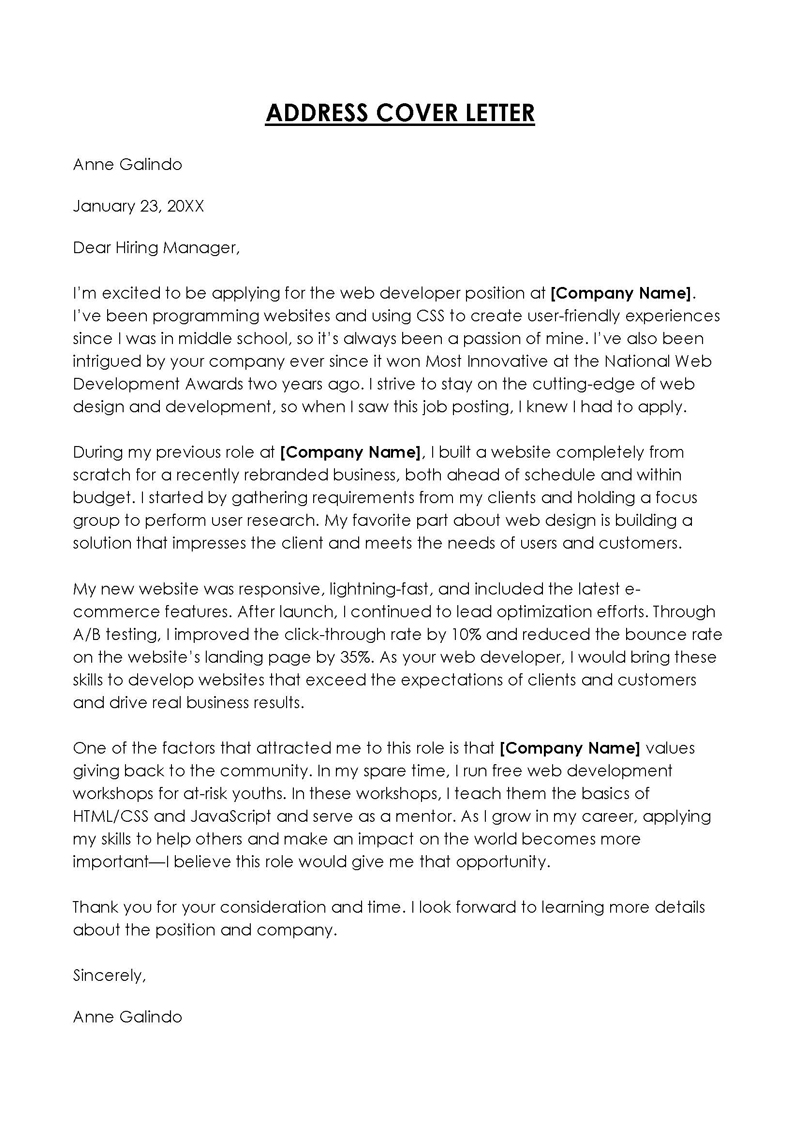20 Examples Of How To Address a Cover Letter to an Unknown Recipient
Introduction.
Imagine sending out dozens of job applications, only to realize that you've been addressing your cover letters incorrectly. As it turns out, addressing a cover letter to an unknown recipient can be a tricky task. In this comprehensive guide, we'll provide strategies for finding the right name, using job titles as an alternative, formatting the letter, avoiding common mistakes, leveraging professional networking, and understanding the importance of personalization. By following our advice, you can increase your chances of landing that job interview and making a great first impression.

Finding the Right Name
Before you give up on finding the recipient's name, consider these research strategies:
Check the job post for a specific name. Sometimes, the name of the hiring manager or contact person is listed in the job posting. Read the post carefully to see if a name is mentioned.
Search the company website for a company directory or listing of key personnel. Many organizations have a "Meet Our Team" or "About Us" section that introduces their staff members. Look for someone with a relevant title, such as "Hiring Manager" or "Human Resources Director."
Call the company directly and ask for the appropriate contact person. If you're unable to find the name online, consider calling the company and asking for the name of the person responsible for hiring for the position you're applying for. This approach can be particularly effective for smaller organizations.
Utilize professional networking platforms like LinkedIn to find the recipient. LinkedIn is a powerful tool for job seekers. Try searching for employees at the company with relevant titles, then check their profiles for clues about their role in the hiring process. You can learn more about how to find the name of the hiring manager using LinkedIn in this helpful article.
Personalize your cover letter. Addressing your cover letter to a specific individual shows that you've done your homework and are genuinely interested in the position. This extra effort can make a big difference in how your application is perceived by the recipient.
Using a Job Title
If you're unable to find the recipient's name, consider using a job title or department head as an alternative:
Address the letter to the job title of the reader. For example, you might write "Dear Hiring Manager" or "Dear Human Resources Director." This approach is more specific and professional than using a generic greeting like "To Whom It May Concern."
Consider addressing the letter to the head of the department where you're applying to work. If you know the department your job falls under, try addressing your cover letter to the department head, such as "Dear Marketing Director" or "Dear IT Manager."
Explain why using a job title or department head can still demonstrate professionalism and personalization. Although it's not as ideal as using a specific name, addressing your letter to a relevant job title shows that you've put some thought into your application and have a clear understanding of the company's structure.
Provide examples of different job titles to use as salutations. You can find a list of different job titles to use as salutations in this resource.
Discuss the potential impact of using job titles on the success of the job application. While using a job title may not guarantee success, it can increase your chances of making a favorable impression. A personalized salutation indicates that you're genuinely interested in the position and have taken the time to research the company.
Formatting the Letter
When addressing a cover letter to an unknown recipient, follow these formatting tips:
Always use "Dear" to start the address. This is a professional and respectful way to begin a cover letter.
Use a gender-neutral title (such as Ms.) if the recipient's gender is unknown. If you're unsure of the recipient's gender, it's better to use a neutral title like "Ms." rather than making assumptions.
For non-gender-specific names, use the recipient's full name. If you can't determine the recipient's gender based on their name, address the letter using their full name, such as "Dear Taylor Smith."
Maintain a professional tone even when the name is unknown. Even if you don't know the recipient's name, it's crucial to keep your language and tone professional throughout your cover letter.
Provide examples of well-formatted cover letter salutations.
While it's always best to try and find the name of the hiring manager or recruiter, there may be times when you just can't find that information. Don't let it deter you. Below are 20 examples of how you can address your cover letter when the recipient is unknown:
1. Dear Hiring Manager, 2. To the Recruitment Team, 3. Dear Human Resources Team, 4. Attention Hiring Committee, 5. Dear [Job Title] Hiring Team, 6. To the [Company Name] Team, 7. Dear [Company Name] Recruiter, 8. To Whom It May Concern, 9. Dear Hiring Authority, 10. Attention [Company Name] Hiring Professionals, 11. Dear Talent Acquisition Team, 12. Hello [Company Name] Selection Panel, 13. Dear Recruitment Advisor, 14. To the [Industry] Professionals at [Company Name], 15. Attention [Company Name] Talent Scouts, 16. Dear Hiring Advocate, 17. To the Selection Committee for [Job Title], 18. Dear [Company Name] Staffing Team, 19. Attention [Job Title] Recruitment Panel, 20. Dear [Company Name] Hiring Panel,
Remember, the goal is to be as respectful and professional as possible in your salutation. Even if you don't know the recipient's name, demonstrating courtesy in your greeting will set a positive tone for the rest of your cover letter.
Also, avoid overly casual greetings like 'Hello' or 'Hi there,' which might seem unprofessional, and stay clear of outdated phrases such as 'Dear Sir or Madam.' Instead, opt for more modern, inclusive alternatives. Be sure to follow your greeting with a comma or a colon, then leave a space before starting the body of your letter.
Avoiding Common Mistakes
When addressing a cover letter to an unknown recipient, it's essential to avoid these common mistakes:
Using generic greetings like "To Whom It May Concern." This phrase is outdated and impersonal, and using it can make your application seem generic and unprofessional. Instead, try to find a specific name or use a job title, as discussed in previous sections.
Using incorrect titles or making assumptions about the recipient's gender. Making assumptions about someone's gender or using an inappropriate title can potentially offend the recipient and hurt your chances of landing an interview. Stick to gender-neutral titles or use the recipient's full name when in doubt.
Addressing the letter to the wrong department or job title. Be sure to double-check that you're addressing your letter to the appropriate person or department. Sending your application to the wrong person can result in your application being overlooked or discarded.
Failing to proofread the cover letter for errors, even in the salutation. Typos and other errors can make a poor impression on the recipient. Be sure to proofread your entire cover letter, including the salutation, before submitting it.
Provide examples of mistakes that could hurt the applicant's chances of landing an interview. Some examples of common errors include misspelling the recipient's name, using an informal greeting (such as "Hey"), or addressing the letter to an unrelated department (e.g., "Dear Accounting Manager" when applying for a marketing position).
Utilizing Professional Networking
Leveraging your professional network can be an effective way to find the name of the recipient for your cover letter:
Use platforms like LinkedIn to research the company and its employees. As mentioned earlier, LinkedIn is a valuable resource for job seekers. You can use the platform to find employees with relevant titles, learn more about the company culture, and even discover mutual connections who might be able to provide an introduction or additional information.
Connect with current employees or alumni of the company. Networking with people who work at the company or have worked there in the past can give you valuable insights into the hiring process and help you identify the appropriate contact person for your cover letter.
Search for the appropriate contact person within your professional network. Use your connections to find people who work at the company you're applying to, and ask if they know who the hiring manager for your desired position is.
Networking can help job seekers get noticed by potential employers. Building relationships with people at the company can increase your chances of getting noticed and potentially even lead to a referral. Learn more about how networking can help job seekers get noticed by potential employers in this article.
Offer examples of successful job seekers who found the recipient's name through networking. For instance, this cover letter that landed a job seeker a role at LinkedIn is a great example of how personalizing your cover letter and leveraging your network can help you stand out.
Importance of Personalization
Personalizing your cover letter can make a significant difference in the success of your job application:
Discuss the impact of personalization on the reader's impression of the applicant. A personalized cover letter demonstrates that you've done your research and are genuinely interested in the position, which can make a positive impression on the recipient.
Provide statistics on the success rate of personalized cover letters compared to generic ones. According to resume statistics , candidates with typos in their cover letters or resumes are 58% more likely to be dismissed, while those who do not include specific employment dates are 27% more likely to be dismissed.
Offer expert opinions on the importance of addressing cover letters to specific individuals. Many career experts agree that addressing cover letters to specific individuals can increase your chances of landing an interview.
Explain how personalization demonstrates research skills and genuine interest in the company. Taking the time to research the recipient and tailor your cover letter to the specific position and company shows that you're not only a thorough and detail-oriented candidate, but also genuinely interested in the opportunity.
Share anecdotes of successful job seekers who personalized their cover letters and landed interviews. For example, one job seeker found the recipient's name through LinkedIn and personalized his cover letter , which helped him land an interview and ultimately secure the position.
Conclusion and Final Thoughts
In summary, addressing a cover letter to an unknown recipient can be challenging, but by following our tips and strategies, you can make a strong impression on potential employers. Remember to:
- Research the recipient's name or use a relevant job title.
- Personalize your cover letter to demonstrate genuine interest in the position.
- Maintain a professional tone and formatting throughout your cover letter.
- Avoid common mistakes that can hurt your chances of landing an interview.
- Leverage your professional network to find the appropriate contact person.
By applying these tips to your job search, you'll increase your chances of success and make a lasting impression on potential employers. Good luck with your job applications!

How to Write a Blind Cover Letter

Teacher Retirement Letter Writing Tips
If you are looking for a position with a company but don't know whether it is hiring, you may need to send a blind cover letter along with your resume. This will make the hiring manager aware of your enthusiasm in working for the company. Even if the company has no current opening for the position you are seeking, the hiring manager likely will keep a clean, polished and memorable blind cover letter on file for future reference.
Research companies within the industry that interests you. Visit websites, browse press releases and read news stories to stay informed about changes in the company and new products and services. Contact anyone in the industry you know who may be aware of which companies are hiring for the position you are seeking.
Address the blind cover letter to the hiring manager, supervisor or human resources contact. Find out by phone, the company website or email the name of the person to whom you should send your blind cover letter.
Begin your blind cover letter by introducing yourself in a memorable and professional manner. Include a brief description of your education, work experience and skills that best suit the company and its operations.
Explain why you are interested in working for the particular company. Mention an interesting fact you learned while conducting research and why your specific skills could benefit the company.
Close your cover letter by expressing interest in a face-to-face meeting. Include a specific date when you will call the hiring manager to arrange an interview.
Search business networking websites for information about hiring managers, human resources managers and executives of specific companies to find names, addresses, titles and departments. Send a hard copy of your cover letter, resume and references. Email copies can be easily deleted or overlooked.
Include a resume and references with your blind cover letter. Carefully proofread all materials because even a minor error can eliminate your chances for a job.
Related Articles

How to Write a Letter for a Student Loan

How to Become a School Cafeteria Worker

How to Start a Student Business Club

How to File a Complaint Against the Federal Student Aid Department

What Are the Courses for Business Management?

Proper Format for a Thank You Letter for a Scholarship

How to Write a Sponsorship Letter for College for Financial Support

Can You Make a Facebook Account for a Pet?
Based in the Washington metro area, Jessica Jones has been a freelance writer since 2006, specializing in business topics. Her fiction has also been featured in publications such as "The Jamaican Observer Sunday Literary Supplement" and at websites including HackWriters. Jones earned a Master of Fine Arts in fiction writing from Lesley University.
What Is a Blind Cover Letter?
- Cover Letters
- ')" data-event="social share" data-info="Pinterest" aria-label="Share on Pinterest">
- ')" data-event="social share" data-info="Reddit" aria-label="Share on Reddit">
- ')" data-event="social share" data-info="Flipboard" aria-label="Share on Flipboard">
Basic Introduction Letter When Starting an Internship
Writing an open cover letter, how to write cover letter templates.
- The Follow Up Letter Before an Interview
- How to Sell Yourself in a Cover Letter
Stepping up your job search might lead you to send blind cover letters and resumes to companies that do not have actual vacancies posted, according to Monster.com . Many job vacancies are never publicly advertised. This is why sending blind cover letters (also known as cold cover letters) may be a productive strategy that could pay off with a new job. Reviewing blind cover letter samples will help you get ideas for ones you might send during your career.
Blind Cover Letter Definition
These are sometimes referred to as unsolicited cover letters, and are addressed to companies that don't have advertised job openings. Job seekers who write blind cover letters typically select companies based on an interest in the organization or news about the organization's growth or expansion.
While some blind cover letters are mere form letters, the most effective ones contain as much personalization as possible. It's wise to research the organization for the name of an HR representative or a hiring manager before sending a letter.
Letters Targeting Industries
Job seekers who focus their search on certain industries might construct a blind cover letter that contains details about their experience in the industry, recommends job search website Indeed.com . For example, a pharmaceutical sales executive who sends a blind cover letter to a drug manufacturer might reference the prescription or over-the-counter medications she has sold throughout her career.
In addition, she can include information in her cover letter that a pharmaceutical firm would appreciate, such as evidence that the job seeker stays abreast of current developments in the industry.
Letters Targeting a Position
In some instances, job seekers send a blind cover letter that's truly blind. That is, they don't have a position in mind. The job seeker's work history is nonspecific, so there could be a number of jobs for which the job seeker might qualify. In some cases, letters are sent because an applicant wants to work for a specific company, explains
A blind cover letter where the job seeker isn't asking to be considered for a specific position highlights transferable skills and asks to be considered for a role based on those skills. For example, a blind cover letter might open with:
"I read with great interest that ABC Retail is opening a new store in Manhattan. I'd like to be considered for a position in the new location based on my background in operations, accounting and administration in a number of industries, such as health care, legal services and manufacturing."
Follow Up After Sending
Blind cover letters require followup. Job seekers who put in the work of sending unsolicited cover letters to numerous employers often indicate when they will follow up with the organization.
The last paragraph of the cover letter typically states, "I will follow up my interest in your company with a call to your office within the next few days. In the meantime, please don't hesitate to contact me if you have questions about my qualifications or credentials." Composing this kind of final paragraph naturally requires the job seeker to research the addressee's direct contact information.
- Monster.com: Cold Cover Letters
- Indeed.com: How to Write a Cold Cover Letter (Template and Example Included)
Ruth Mayhew has been writing since the mid-1980s, and she has been an HR subject matter expert since 1995. Her work appears in "The Multi-Generational Workforce in the Health Care Industry," and she has been cited in numerous publications, including journals and textbooks that focus on human resources management practices. She holds a Master of Arts in sociology from the University of Missouri-Kansas City. Ruth resides in the nation's capital, Washington, D.C.
Related Articles
How to write a cover letter to a previous employer, how to write an unsolicited cover letter, steps to writing a cold call letter for employment, is cold calling effective when job searching, how to write a cover letter to a company that does not have a job opening, an example of a cover letter follow-up, how to write a cover letter for an unadvertised job, how to write a letter to reject an interview, how to write a simple application cover letter, most popular.
- 1 How to Write a Cover Letter to a Previous Employer
- 2 How to Write an Unsolicited Cover Letter
- 3 Steps to Writing a Cold Call Letter for Employment
- 4 Is Cold Calling Effective When Job Searching?
The 3 Rules of Addressing Your Cover Letter in 2023

You’ve finally sat down to write that cover letter (good for you!), but immediately you run into a roadblock: How do you even start the darn thing? Who do you address it to? Should you use Mr. or Ms.? Do you include a first name? And what if you’ve searched high and low, but can’t find the hiring manager’s name?
Don’t fret! Follow these three rules for cover letter salutation salvation.
Rule #1: Address your cover letter to the hiring manager using a formal, full-name salutation (if possible).
For a cover letter, you should always default to addressing it to the hiring manager for the position you’re applying to. Unless you know for sure that the culture of the company is more casual, use the hiring manager’s first and last name. You can include a title, such as “Mr.” or “Ms.” (never Mrs. or Miss). But if you aren’t crystal clear on whether to use “Mr.” or “Ms.” and can’t find their pronouns with a little Google and social media searching (and you don’t have an easy way out with a “Dr.”), just drop the title. Omitting it is infinitely better than accidentally misgendering someone .
Most letters I see still use the “Dear” greeting, though I’ve seen a growing trend of people dropping it and starting with “Hello” or just the name. Any of these works. The most important part is having the actual name . Never use “ To Whom it May Concern ” or “Dear or Sir or Madam”—nothing could be more generic (not to mention archaic). Your cover letter could be the first opportunity you have to make an impression on the hiring manager, so make sure you show that you did your research .
For example, you can address your cover letter by saying:
- Dear Ms. Jacklyn O’Connell,
- Hello Mr. Kevin Chen,
- Dear Niko Adamos,
- Hello Jean Butler,
- Tiana Richards,
Rule #2: If you don’t know the hiring manager, guess.
Sometimes, even after hours of online searching ( try these tips ), you still might not be able to definitively figure out who exactly the hiring manager for the position you’re applying for is—and that’s OK.
If you can only find a list of the company’s executive team, use the head of the department for the position you’re applying for. In the end, no one will fault you for addressing the letter higher up than necessary. This approach is definitely better than not using a name in your cover letter, because it still shows the time and effort you took to find out who the department head is.
Rule #3: Be as specific as possible.
So you’ve done your due diligence and after an exhaustive search—nothing. You just can’t find a single name to address your cover letter to. If that’s the case, don’t worry. The company is likely privately held with no reason to share who its employees are—and, more importantly, is aware of this.
If this is the case and you don’t have a name to use, try to still be as specific as possible in your greeting. Consider using “Senior Analyst Hiring Manager” or “Research Manager Search Committee”—something that shows that you’ve written this letter with a particular audience in mind and aren’t just sending the same generic letter for every job opening.
For example:
- Dear Software Developer Search Committee,
- Hello XYZ Co Marketing Team,
- Dear Junior Accountant Hiring Manager,
Ultimately, you want your cover letter to convey your interest in the position. To start off on the right note, make your salutation as specific as possible—ideally with the name of the hiring manager. Of course, that can’t always happen, but as long as the effort is clearly made, you’ll be showing whoever reads your cover letter that you’ve put time into your application and are truly excited about the opportunity.
Regina Borsellino contributed writing, reporting, and/or advice to this article.
- Get the Job
- Resumes and CVs
- Applications
- Cover Letters
- Professional References
Professional Licenses and Exams
- Get a Promotion
- Negotiation
- Professional Ethics
- Professionalism
- Dealing with Coworkers
- Dealing with Bosses
Communication Skills
Managing the office, disabilities, harassment and discrimination, unemployment.
- Career Paths
- Compare Careers
- Switching Careers
- Training and Certifications
- Start a Company
- Internships and Apprenticeships
- Entry Level Jobs
- College Degrees
Growth Trends for Related Jobs
How to write a cover letter to a blind ad.

When responding to a job posting, ideally, you should tailor your cover letter to the company and the position to which you're applying. That’s difficult with a blind ad because you know little about the employer and the opportunity. Even in the absence of identifying information, however, you can still create a standout letter that showcases your professionalism, skills and knowledge.
Research the Company
It’s important to understand the organization and the job before submitting a cover letter and resume, but without this information, it’s difficult to elaborate on why you’re a good fit. Even without specific information, you might be able to uncover both the organization and the person in charge of hiring for the position. If the posting includes a fax number, address or P.O. Box, you can sometimes track down the company through an Internet search. You can also search for specific phrases within the ad, such as “our company was ranked number one in customer service the past three years.”
Addressing the Letter
Cover letters make a greater impact when addressed to a specific person rather than opening with a generic greeting. If you can identify the company behind the ad, browse the organization’s website to determine who oversees hiring, or call the company and ask. If you cannot find any specific information, address your letter “Dear Hiring Manager.” or “Dear Recruiter.” “To whom it may concern” and “Dear Sir/Madam” are considered outdated and impersonal. Another standard greeting, “Dear Sirs,” might even offend the employer if she’s a woman.
Describing Your Qualifications
Tailoring your experience, skills and other qualifications to the position is more challenging when you don’t know what company you’re applying to. Some ads offer little specific information about the job, possibly because the employer doesn’t want to be inundated with phone calls if applicants discover who placed the ad. Review the posting line-by-line and determine how you fulfill each qualification. Outline this in your letter by listing each requirement and adding an example or anecdote demonstrating your proficiency and skill in this area.
Ending Your Letter
A strong close is crucial in any cover letter, but when replying to a blind ad it can make all the difference. If you can’t uncover the employer’s identity, you won’t have the opportunity to follow up on your resume and reiterate your interest and qualifications. Conclude your cover letter with a statement such as “Based on the qualifications you listed in the job posting, I feel my skills and background are a perfect match for the position, and I’m excited to learn how I can contribute to the company’s growth. I look forward to discussing this with you in more depth at a face-to-face interview. I hope you’ll consider me for the position.”
Related Articles
How to write a letter requesting a future job opening →.

How to Do a Cover Letter for a Job Application →

The Difference Between a Cover Letter & Letter of Interest →

How to Address a Cover Letter When the Name Is Unknown →

How to Follow Up an Inquiry Letter →
How to write a cover letter to a company that does not have a job opening →.

- Business Insider: Two Easy Ways To Find Out Exactly Who's Behind A Job Listing
Medioimages/Photodisc/Photodisc/Getty Images
- Job Descriptions
- Law Enforcement Job Descriptions
- Administrative Job Descriptions
- Healthcare Job Descriptions
- Sales Job Descriptions
- Fashion Job Descriptions
- Education Job Descriptions
- Salary Insights
- Journalism Salaries
- Healthcare Salaries
- Military Salaries
- Engineering Salaries
- Teaching Salaries
- Accessibility
- Privacy Notice
- Cookie Notice
- Copyright Policy
- Contact Us
- Find a Job
- Manage Preferences
- California Notice of Collection
- Terms of Use
Writing an Effective Unsolicited Cover Letter
An unsolicited cover letter is one the hiring manager didn’t explicitly ask for through a verbal or written request. While many people send cover letters in response to job postings or referrals, unsolicited cover letters can help you show initiative and land jobs that aren’t advertised. Learning to write one of these letters in a way that positions you as an attractive candidate is the key to success.
What are the benefits and drawbacks of an unsolicited cover letter?
If you’re the kind of candidate who has only ever responded to job postings, the idea of writing an unsolicited cover letter may be intimidating. Learning about the pros and cons of unsolicited cover letters can help you determine whether this bold approach is right for you.
Standing out from other applicants
Many people are hesitant to send unsolicited cover letters because they worry about coming across as overly eager or self-confident. What most cover letter articles won’t tell you, though, is that an unsolicited cover letter can help you stand out in a good way.
This move may get you noticed more easily because you won’t be competing with hundreds of other applicants. Your cover letter will arrive unexpectedly, giving the hiring manager time to focus on reviewing your qualifications.
It demonstrates initiative and motivation
Sending an unsolicited application cover letter shows that you’re a proactive candidate who knows how to take the initiative. Hiring managers will likely see you as a self-starter, a trait often associated with high-performing employees.
Sending an unsolicited cover letter also showcases your excitement and motivation regarding the position and company. If the prospect of working at a particular business prompted you to send an unsolicited cover letter, it’s safe to assume you have an authentic desire to work there.
Sending an unsolicited application cover letter shows that you’re a proactive candidate who knows how to take the initiative. Hiring managers will likely see you as a self-starter.
Uncovering hidden jobs
It may surprise you to learn that many companies don’t advertise all of their vacant roles. Sometimes, it's because they want a narrower pool of candidates with specific experience or skills. Other times, the HR manager or business owner just doesn’t have the time to sift through hundreds of applications.
In these cases, an unsolicited cover letter can help open doors for you. If the company has an unadvertised open position, you may be first in line for consideration.
When competition for top talent is fierce, hiring personnel may not be accustomed to having great candidates come to them. The hiring manager may appreciate you making their talent acquisition journey easier.
However, it takes a lot of effort and time
It’s important to note that sending a cold application never guarantees that you’ll land the job or even receive an interview. There may be times when the company doesn’t have any open positions, prefers to hire from within, or already has candidates in mind for the job. Consequently, unsolicited cover letters can be hit and miss.
Moreover, these letters take considerable time and effort to write. While you may be rewarded with a great position, be prepared to do a lot of work on the front end to get it.
How to write an effective unsolicited solicited cover letter
While unsolicited cover letters have some elements in common with general cover letters, there are some additional steps you’ll need to take. Here are a few key pointers and best practices to keep in mind.
Research the company and role when possible
It’s important to do your research when writing any cover letter, but it’s even more critical when your application is unsolicited.
The hiring manager will likely wonder what prompted you to send an application without seeing a vacant position. You need to preemptively explain to them what it is about the company or job that interested you.
Customize your letter
Just because you’re sending an unsolicited application doesn’t mean it should be generic. Hiring managers will appreciate a customized letter, as it makes your intentions for sending it clear.
A specially tailored cover letter is also more compelling, as it allows you to align your experience and skill set with the company’s needs and showcases the effort you’ve put in, which is key for a cold application.
Highlight relevant skills and experience
Anytime you send an unsolicited cover letter, you must make it a point to highlight how you could be of value as an employee of the company.
This is where your research will come in handy. Use what you know about the organization’s culture, values, mission, and goals, as well as the position you want, to introduce relevant skills and anecdotes that relate to these aspects.
Use appropriate language and tone
Because you won’t have any familiarity with the company or hiring manager, it’s even more important to maintain a professional tone throughout your letter.
Resist the urge to inject humor, as you never know how it might come across to the hiring manager. As many cover letter and resume articles advise, you should also avoid using slang or other types of informal language.
Use a cover letter template
Using cover letter templates can give you a better idea of what sections to include and help ensure that your letter is formatted correctly. Unsolicited cover letter examples will also help you nail the right tone, as you’ll get a chance to see how you can incorporate formal and professional language into your letter.
Expert Tip:
Keep your unsolicited cover letter to one page or less in length. Remember, you’re sending your letter without anyone having requested one. Writing a concise letter shows that you respect the hiring manager’s time and don’t want to waste it.
Key points when sending
It’s especially important to adhere to best practices when sending an unsolicited cover letter. Keep the following key points in mind as you compose your letter.
Attach your resume
Make sure the hiring manager has everything they need to evaluate you as a candidate. Don’t forget to include your resume , as it’s a crucial document that summarizes your experience.
If you need help crafting a good resume, consider using resume templates . These helpful frameworks will show you exactly what to include and how to format it.
Address the hiring manager properly
Avoid using generic greetings like “To whom it may concern” or “Dear sir/madam” as your salutation. Instead, show the hiring manager you’ve researched the company and put effort into your application by addressing them by name.
If you don’t know their name, try looking them up on LinkedIn, or just call the company and ask directly. Once you have a name, stick to proper titles like “Mr.” or “Ms.” to maintain a sense of formality.
Acknowledge it’s an unsolicited letter and application
There’s no need to feel awkward about sending a blind cover letter, especially if you truly feel you can provide value to the company.
That said, you should acknowledge that your letter is unsolicited and explain why you’re sending it to avoid any misunderstanding. Doing so sets a tone of honesty and transparency and establishes trust between you and the hiring manager.
Thank the contact person or hiring manager
Make sure to express sincere gratitude to the person reading your application.
Since your letter is unsolicited, you can’t be sure it will arrive at a good time for the hiring manager. Thanking them for reading your materials acknowledges that they’re going out of their way to consider you as a candidate and will make them feel appreciated.
An unsolicited cover letter can be a bold move toward your dream job
Sending an unsolicited cover letter is a bold move that will make you stand out as an applicant. However, many hiring managers will appreciate you taking the initiative to contact them and articulate how your skills can be of value to their company.
When writing your letter, research the company thoroughly, address the hiring manager by name, and maintain the appropriate tone throughout. Acknowledging that your letter is unsolicited can also help you establish transparency and trust.
If you want to craft the perfect application, use cover letter and resume examples to guide your content and formatting. These tools can go a long way toward helping you craft an application package that will get you noticed so you can land the perfect position.
Get ahead of the competition
Make your job applications stand-out from other candidates.

Achieving the Ideal Cover Letter Length

How to Create a Cover Letter in Spanish

Writing a Cover Letter for Internal Positions

6 Examples: How To Address a Cover Letter Without a Name
By Status.net Editorial Team on December 25, 2023 — 11 minutes to read
Addressing the recipient without knowing their name might seem complicated, but there are ways to navigate this situation. Let’s take a look at a few strategies to make your cover letter feel personalized even when you don’t have a specific name to address.
Be Professional and Engaging
Using general salutations like “To Whom It May Concern” or “Dear Sir/Madam” can make your cover letter feel impersonal. Instead, opt for a more engaging opener such as “Dear Hiring Manager” or “Dear [Company Name] Team.” This type of greeting acknowledges the company and shows that you have researched the team you are addressing.
Focus on the Position and Company
Make sure to tailor the content of your cover letter to the job you are applying for by highlighting relevant qualifications, experience, and skills. Share specific examples of your successes that align with the responsibilities of the position. Mention the company’s values, goals, or recent successes to demonstrate how your values align with theirs. This can effectively showcase your interest and commitment to the role.
Use LinkedIn and Company Website Research
If you cannot find the hiring manager’s name in the job posting, you can turn to LinkedIn or the company website for clues. Search for professionals working in human resources or hiring roles at the company. If you find a specific contact, address your letter to that person while using their full name and title. Otherwise, continue with a professional and engaging salutation as mentioned earlier.
Here are two examples of how to start a cover letter without a name:
Dear Hiring Manager, As a passionate marketer with five years of experience, I am excited to apply for the Marketing Manager position at (…) Company. Achieving a 30% increase in leads generated through my previous campaigns, I am eager to contribute to the growth of your marketing department.
Dear ABC Inc. Team, With a strong background in project management and a proven track record of implementing cost-saving strategies, I am confident in my ability to excel as the Senior Project Manager at ABC Inc. Your company’s commitment to sustainable practices aligns with my values and I am thrilled to be considered for this opportunity.
By applying these strategies, you can create an impactful and personalized cover letter, even without knowing the recipient’s name. This attention to detail can set you apart from other applicants and leave a positive impression with your prospective employer.
How to Find the Hiring Manager’s Name
Sometimes locating the hiring manager’s name can be tricky, but there are several ways to find it. Let’s go through a few methods to help you address your cover letter without a name.
Using LinkedIn
LinkedIn is a great resource for finding the hiring manager’s name. Here’s how you can use it:
- Visit the company’s LinkedIn page.
- Click on the “People” tab to browse through the employees.
- Use the search bar and enter keywords such as “recruiter,” “hiring manager,” or the department you’re applying to.
- Check the found profiles, and try to identify the right person responsible for hiring in your desired role.
Make sure to double-check that the person is currently working in the company to avoid using outdated information.

Checking Company Website
Another way to find the hiring manager’s name is by checking the company website:
- Locate the “About Us” or “Team” page, where you might find a list of employees along with their titles and roles.
- Look for a person who has a recruiting or hiring-related title within the department you’re targeting with your application.
- If you cannot find the necessary information on the website, try checking a company’s press releases or blog. Sometimes they include names of important team members.
Making a Phone Call
When all else fails, you’re left with one more option – making a phone call.
- Call the company’s main line and politely ask the receptionist for the name of the hiring manager or the person responsible for recruitment in the department you’re interested in.
- Be prepared to provide the job title and a job reference number (if available) to help the receptionist find the right person.
Finding the hiring manager’s name isn’t always possible. If you cannot locate it, don’t worry. Addressing your cover letter as “Dear Hiring Manager” or “To Whom It May Concern” is still better than not sending a cover letter at all.
How To Address a Cover Letter Without a Name: Sample Phrases
Starting with job title.
When you cannot find the recipient’s name, use their job title to address the cover letter. This shows that you can connect and direct your message to the relevant person. Here are some examples:
- Dear Hiring Manager, – This is a common and universally understood phrase for addressing a cover letter without a name.
- Dear [Job Title], – Use the specific job position that the recipient holds, for instance, Dear Marketing Director .
- To the [Job Title] Selection Committee, – This approach can be useful when applying for a role advertised by a team or committee that will handle the hiring process, such as To the Scholarship Selection Committee .
Referring to Department
Another approach is to address the cover letter to the department that the position is within. This helps to direct your message to the appropriate team or group. Here are some examples:
- Dear [Department] Team, – Mention the department you are applying for, such as Dear HR Team, or Dear Sales Team .
- Greetings, [Department] Department, – Use the department name to address the letter, like Greetings, IT Department .
- To Whom It May Concern in the [Department], – This is a formal alternative when you don’t know the recipient or department’s name, for example, To Whom It May Concern in the Finance Department .
Using these approaches will ensure that your cover letter appears professional and well-directed, even when you don’t have the exact name of the recipient. Focus on the content and the skills you bring to the position to make the best impression on the reader.
Crafting Content for Cover Letters
When you’re unsure of the recipient’s name, you might feel a little lost on how to address your cover letter. Don’t worry. You can still create an engaging and professional cover letter that gets the job done. Here are some tips and examples to help you craft the perfect content for an anonymous cover letter.
Start with a professional, yet friendly, greeting. If you don’t know the hiring manager’s name, use a general opening line such as “Dear Hiring Manager” or “To Whom It May Concern” . These greetings are widely accepted and show respect towards the person receiving the letter.
Next, dive into your strengths, skills, and achievements. Mention the qualifications that make you a strong candidate for the position. Share relevant accomplishments from your previous roles, such as leading a successful project or boosting sales. Be specific when describing your skills and use quantifiable results when possible. For example:
“During my time at Company (…), I managed a team of 10 and successfully increased sales by 25% within six months.”
Show enthusiasm for the job and demonstrate your knowledge of the company. Research the organization’s goals, values, and recent projects, then incorporate this information into your cover letter. This will help you tailor your letter to the company’s needs and show that you’d be a good fit for their culture. You could say something like:
“As a long-time admirer of your company’s commitment to sustainability, I’m excited about the opportunity to contribute to the upcoming eco-conscious product line.”
Close your cover letter with a strong call-to-action. Express your interest in further discussing your qualifications and offer your availability for an interview. Thank the hiring manager for considering your application and include your contact information. A sample closing paragraph could look like this:
“I’m eager to discuss how my expertise in digital marketing could contribute to the success of your team. Thank you for considering my application. You can reach me at (555) 555-5555 or [email protected] to schedule a conversation.”
Keep your cover letter concise and focused on your unique selling points. Even without knowing the recipient’s name, following these guidelines will allow you to create a memorable and attention-grabbing cover letter that leaves a lasting impression on potential employers.
Tips on Prefix Usage
When you’re addressing a cover letter without a specific name, it’s good to think about the appropriate prefix to use. Here are some tips to help you choose the right one:
First, consider using a general and gender-neutral prefix like Dear Hiring Manager . It will work well if you don’t know the recipient’s name or aren’t aware of their gender. This is a widely accepted way to address a cover letter without a specific name.
Dear Hiring Manager, I came across your job posting for a Graphic Designer, and I am excited to apply for the role.
If you happen to know the job title of the person who will read your cover letter, you can use it. This shows that you have put effort into researching the company and position.
Dear Marketing Director, I am writing to express my interest in the open Digital Marketing Specialist position at your company.
In some cases, you might know the name of the department that the job is in. In this case, you can address your cover letter to the entire department.
Dear Finance Team, I was thrilled to see an opening for a Financial Analyst at your company and would like to apply for the position.
When you’re unable to find any specific details or when addressing a larger company, you can opt for a broad salutation like To Whom It May Concern . Just be aware that it may come off as impersonal, so it’s best to use this as a last resort.
To Whom It May Concern, I am submitting my application for the Content Writer position posted on your careers website.
The key is to maintain a professional tone throughout your cover letter. Regardless of which prefix you choose, always customize your content to suit the specific job and company you’re applying to. By doing so, you demonstrate a genuine interest in the role and leave a positive impression on the hiring manager.
Common Mistakes to Avoid
Sending a cover letter without addressing it to a specific person can be a pitfall. It might make the recipient feel unimportant or signal that you didn’t do your research. To make your application stand out, be mindful of these common mistakes:
- Not being specific about the role: Your cover letter should not only address the person but also the specific role you’re applying for. Tailor your letter according to the job and the company. For instance, instead of writing “I wish to apply for the marketing position”, be more specific like “I am interested in applying for the Digital Marketing Specialist role at [CompanyName].”
- Focusing too much on yourself: Although your achievements are important, the cover letter should focus on how your skills can benefit the company. Frame your accomplishments in a way that highlights the value you can bring to the organization.
- Being overly formal or stiff: While it’s important to maintain a professional tone, being too formal might come across as insincere or impersonal. Use a friendly tone and avoid jargon or buzzwords to keep your cover letter genuine and relatable.
- Spelling errors and typos: Even the smallest of typos can create a negative impression. Double-check your cover letter to make sure there are no mistakes. Keep an eye out for incorrect spellings, especially when addressing the recipient.
The goal of your cover letter is to make a personal connection and showcase how you are a great fit for the company. Taking the time to address your letter properly, proofread for errors, and customize your content demonstrates your attention to detail and commitment to the position.
Frequently Asked Questions
How can i properly address a cover letter when the recipient’s name is unknown.
If you don’t know the recipient’s name, consider using a general salutation instead. For example, “Dear Hiring Manager” or “Dear Recruitment Team” acknowledges the recipient without using a specific name. You can also research the company’s website or LinkedIn to try to find the appropriate contact person.
What alternatives are there to ‘To Whom It May Concern’?
There are several alternatives to ‘To Whom It May Concern’ that can help make your cover letter stand out:
- Dear Hiring Manager
- Dear [Company] Team
- Dear [Department or Job Title] Hiring Team
- Dear [Company] Recruitment Team
How do I determine the appropriate salutation for my cover letter?
To determine the right salutation for your cover letter, do a bit of research on the company or organization you’re targeting. This may help you uncover the specific department or hiring manager’s name. If not, use one of the general salutations mentioned earlier to address your cover letter in a more personalized manner.
What are examples of cover letter openings without using names?
Here are some examples of cover letter openings without using specific names:
- “Dear Hiring Manager, I am excited to submit my application for the [Job Title] position at [Company].”
- “Dear [Department or Job Title] Hiring Team, As a passionate professional with experience in [Industry], I am eager to contribute to [Company] as a [Job Title].”
- “Dear [Company] Team, I recently came across the [Job Title] opening at [Company], and I am confident that my skills and experience make me a strong candidate.”
How can I avoid common mistakes when addressing cover letters without names?
To avoid mistakes when addressing cover letters without names, follow these tips:
- Do thorough research on the company and the job posting
- Be concise and professional in your language
- Use an appropriate general salutation if you can’t find a specific name
- Double-check for spelling and grammatical errors before sending the cover letter
- Avoid using outdated or overused phrases, such as ‘To Whom It May Concern’ or ‘Dear Sir/Madam’
By following these guidelines, you can create a strong and effective cover letter that stands out to hiring managers, even if you don’t have a specific name to address.
- How to Send an Email Cover Letter (Examples)
- Resume vs. Cover Letter (Thoughtful Tips)
- 3 Administrative Assistant Cover Letter Examples (Guide)
- 10 Inspiring Examples: How To Write a Cover Letter
- Cover Letter vs. Letter of Interest vs. Letter of Intent
- 2 Smart Examples: Executive Assistant Cover Letter
WTO / Letters and Emails / Cover Letters / How to Properly Address a Cover Letter (with Examples)
How to Properly Address a Cover Letter (with Examples)
A cover letter is an official one-page document you submit as part of your job application alongside your resume or curriculum vitae.
The main aim of writing this letter is to highlight your professional background to the hiring manager or potential employer.
A well-written cover letter can spark the prospective recruiter’s interest and get them to read your other job application materials. However, a poorly formatted letter might mean that your job application documents will be disregarded, and you want to make sure this does not happen. As such, before you start writing this letter, you must have adequate information on how to draft an effective cover letter, starting with how to address the letter correctly.
How you address your cover letter is very important, as this is usually the first thing the hiring manager reads when going through it. A well-formulated cover letter address shows your enthusiasm for the job and demonstrates your attention to detail skills.
This is because it will be specific (i.e., include the hiring manager’s name and title), indicating that you took your time researching the company and the cover letter recipient. Moreover, addressing your letter properly sets the tone for the rest of your letter, making your job application stand out.
Free Templates

How to Address a Cover Letter Properly
Knowing how to address your cover letter professionally and appropriately will enable you to make a positive impression on the recruiter reviewing your letter, increasing your prospects of getting more job interviews and ultimately landing the position you were hoping to secure.
The following are different methods of addressing the situation, depending on the situation:
Addressing a cover letter with no name
The most appropriate way of addressing this letter is to use a formal salutation addressed directly to the recruiter or hiring manager using their full names. However, in some cases, research into the company and whom to address the cover letter to may not disclose the recruiter’s name. In such a situation, you can explore alternative methods of addressing the letter that do not negatively impact your chances of getting a job interview.
These include:
Use academic or professional title
Using the recipient’s right academic or professional title is considered an excellent greeting option. It demonstrates that you read the job description and tailor your greeting based on the company department where the job position is currently available, the hiring manager’s title, or the team with which you will potentially work. Nonetheless, you will need to be as specific as possible to demonstrate that you have done your research and aren’t just sending a generic cover letter to many recruiters from different companies hoping to land a position in either of the companies.
Examples of professional greetings in such a scenario include:
- Dear Customer Support Hiring Manager/Team, in the event you are applying for a customer service representative position
- Dear Chief Financial Officer/Accounting Manager, if you are applying for an accounting position
- Dear Talent Acquisition Team
- Dear Human Resources Manager, among others.
- No salutation
If you cannot find the recipient’s name, do not know the recipient’s professional or academic title, and are unsure of the department where the job is currently available, you can opt to skip the salutation and start your cover letter with the introductory paragraph. This is advisable, as it avoids the chance of making things worse. However, it is essential to note that this should be considered a last resort, as not including a salutation may come across as being rude, overly lazy, or implying that you do not know how to write this letter, all of which may put you out of contention for the job.
Use “dear hiring manager”
If you cannot find any specific name or sufficient department information, use the “dear hiring manager” salutation, as it sounds professional and is gender-neutral. Some applicants like to use “Dear Sir/Madam” as a generic salutation for cover letters, but its use is a bit old-fashioned. In addition, it may be considered overly formal by some employers. The “To Whom It May Concern” greeting is also discouraged as it sounds too impersonal and outdated.
Other options
The most common and acceptable way to address a cover letter when the letter’s recipient is unknown is by using the ‘Dear Hiring Manager” greeting.
Still, you can use other alternative greetings, including:
- Dear IT Department
- Dear Company ABC Hiring Manager/Recruiter
- Dear Head of Nursing
- Dear Company XYZ Team
- To the Catering Department, etc
Addressing using a formal full name
Generally, most job descriptions or job postings will provide the name of the hiring professional or the manager you will be working for. In such cases, it is preferable to address your cover letter formally using the hiring professional’s first and last name. Addressing your letter using the recipient’s formal full name establishes a personal connection and sets the right tone for your letter.
- Dear John Doe
- Dear Alexis Brown
- Dear Johnson Kingstone
Using gender-specific titles such as Mr., Ms., or Mrs. is only advisable if you are sure of the receiver’s gender and marital status. Suppose you know the hiring professional personally and they have told you their preference; you can use their title and last name when addressing the cover letter.
- Dear Mrs. Patterson
- Dear Mr. Stanley
- Dear Ms. Rodríguez
Given that your contact has a professional title that you are aware of, you may want to replace the gender-specific titles such as Mr. or Mrs. with the receiver’s professional title or honorifics, as this is considered more respectful. For example, if the letter’s addressee is an individual with a medical or doctorate degree, you will need to write Dr. before their name as a sign of respect.
More examples
- Dear Prof. Hussein
- Dear Rev. Purity Smith
- Dear Lt. Angelou
Address using the only name for a non-gender-specific name
If you know the hiring officer’s name but cannot definitively tell their title, gender, marital status, or preferred pronouns, it is best to address them using only their full name to avoid any mistakes.
- Dear Alex Brown
- Dear Jamie Brown
- Dear Mohamed Ahmed,
- Dear Tiffany Hale
When addressing a cover letter, it is best to be as specific as possible and personalize it accordingly to impress the hiring professional and compel them to read the rest of your letter.
Including a specific name and title is always considered the best way to address a cover letter.
However, if your research efforts do not disclose the hiring manager’s name, you can still be as specific as possible and consider using the department or academic title, or address your letter in a more generalized manner but with a particular audience in mind.
How do You Find Out to Whom to Address a Cover Letter?
Most organizations provide the names of the hiring managers so that applicants immediately know to whom to address the letter.
However, in cases where you are not given the recruiter’s name, consider the following effective ways to discover whom to address your cover letter:
Double-check the job posting
The most convenient way to find out the name of the hiring professional is to double-check the job posting or job description. This is because most job descriptions contain comprehensive information on job application submission criteria, which generally include the letter’s receiver.
Examine the email address provided in the job description
If the hiring manager’s name is not included in the job description or is not apparent to you, you can discover the hiring manager’s name by examining the email address provided in the job description. For example, if the email address provided in the job description is [email protected], a Google search combining the person’s name as indicated in the email and the company name might find you the hiring manager’s full name. However, this may not always work, as some organizations prefer to use business emails.
Check LinkedIn
LinkedIn job postings often include the name of the person offering the job. LinkedIn’s profile name is more often than not the hiring manager’s name, and you should use that name in your address line.
Check the company website
Suppose the company you are applying to has an official company website. Then try to find the head of the relevant department on the company’s staff page or do a LinkedIn company search.
The supervisor’s title
In most cases, job descriptions list who the new hire will report to, such as the head/director of accounting, the director of nursing services, etc., without disclosing a specific name. In this case, there are various search options you can explore to find out the hiring manager’s name.
This includes running an advanced LinkedIn or Google search for all directors of accounting or nursing services in that company, checking with your network for someone who might have an idea of the person’s name, including your professional networks, or searching the company site for listings of staff members by title.
If all of the above-mentioned options fail, you can consider contacting the company by phone or email and telling them that you are applying for a specific job position. Still, there are chances that you may not find the contact person, and you would like to address your cover letter to the right person.
How to Address an Email Cover Letter
If the company’s preferred job application submission criterion is through email, you will need to format your cover letter in the email’s body or as an attachment along with your resume. If you are formatting the letter in the email’s body, create a strong subject line that is clear and concise to enable the recipient to know the purpose of the email. Your subject line should include the job title you are applying for, your full name, and a phrase that reiterates what the email contains.
After providing a suitable subject line of 6–10 words long, include a professional and specific salutation. If you know the addressee’s name, address the letter to them using either their full name or “Mr.” or “Ms.” preceded by their full names. If the recipient has a professional or academic title, such as “Dr.” or “Prof.”, use that in place of Mr. or Mrs.
Subject Line: Job Application for Financial Analyst, Jessica Jones Dear Mr. John Doe, or Dear Dr. Vincent Hopkins,
If you are unable to determine the recipient’s name from the email provided or through a quick search, use a general salutation such as “Dear Hiring Manager” or leave out the salutation and begin your letter with the introductory paragraph.
Once you have selected a suitable salutation, follow it with a comma or colon, skip a line, and then start the first paragraph of your letter. This applies to letters sent via email or traditional mail.
Do’s and Don’ts for Addressing a Cover Letter Properly
These letters are formal; thus, they should always be addressed professionally and with a specific audience in mind to demonstrate an applicant’s professionalism and attention to detail.
Discussed below are the steps for addressing a cover letter:
Do some research to find the hiring manager’s name
Whenever possible, this letter should always be addressed to someone specifically in their official name. This makes the letter seem more personalized to the reader and helps differentiate you from other candidates. Therefore, do research and try to find the hiring manager’s name. However, if you can’t find the recruiter’s name, you may list the contact name as “Hiring Manager.”
Do read job descriptions for the hiring manager’s name
Double-checking the job description to find out the hiring manager’s name or whom you will report to if you are hired is very important as it shows your keenness and attentiveness skills, which most employers look for in potential employees.
Do customize your letter to the audience
If you research the company website and LinkedIn profiles, double-check the job description or email address, and you are still not able to find the letter recipient’s name, consider customizing your letter to a specific audience rather than a specific individual. You can address the letter to the department, faculty, the company, or the overall hiring manager.
Discussed below are the don’ts for addressing this letter:
Don’t use “to whom it may concern.”
While some applicants prefer to address their letter to ‘To Whom It May Concern” in cases where the department head, exact department, or recruiter’s name is unknown, it is greatly discouraged, as it is impersonal and outdated.
Don’t use “Dear Sir or Madam.”
Using dear sir or madam as a greeting line in cover letters is also discouraged, as it is overly formal and old-fashioned. While it may seem logical to address an unknown recipient, it is impersonal and might not fit the specific company culture.
Don’t address a letter incorrectly
Knowing how to address your letter correctly makes you a very visible and appealing candidate to potential employers. On the other hand, addressing your letter incorrectly may create a negative picture of you in the hiring manager’s mind, thus reducing your chances of getting a job interview.
Don’t address using “Hello or hi.”
The address line of this letter should be written formally to maintain a sense of professionalism. Starting the salutation with greetings such as “hello,” “Hi,” and “hey” makes the tone of the letter informal, which is incorrect. Always consider starting your salutation with “Dear…” or simply writing the addressee’s full name.
Final Thoughts
Knowing how to address your cover letter properly can make the difference between your application being noticed and overlooked by hiring professionals. The most appropriate way to address it is by personalizing it for the recipient using their first and last names. There are various effective ways to find the recipient’s name, including double-checking the job description, examining the given email address, checking LinkedIn and the company website, or contacting the company via email or a phone call. However, if these targeted searches do not find you the hiring manager’s name, there are other acceptable strategies to address your letter in a more generalized but specific manner. Remember that “To Whom It May Concern” and “Dear Sir/Madam” are inappropriate salutations for a cover letter, as they are impersonal and outdated.
About This Article

Was this helpful?
Great! Tell us more about your experience
Not up to par help us fix it, keep reading.

Cover Letters
7 great examples of cover letters for job application.

Product Manager Cover Letter (Free Templates)

Real Estate Cover Letter Examples (Expert Tips)

New Graduate Nurse Cover Letter (18 Best Examples)

Graphic Designer Cover Letter (Templates & Sample)

Pharmacy Technician Cover Letter Examples (Expert Tips)

Administrative Assistant Cover Letter Examples + Tips

Business Analyst Cover Letter Examples (Free Templates)

Free Eye Doctor Note Templates

Authorization
Authorization letters to travel with minor.

Sample Landlord Reference Letters for a Tenant

12 Free Vehicle Authorization Letter Templates
Thank you for your feedback.
Your Voice, Our Progress. Your feedback matters a lot to us.
How to address a cover letter | with examples
The way you start your cover letter counts.
It’s the first thing a hiring manager sees when they open your application so you need to make them excited to peek into your CV .
In our guide, we’ll show you the ropes on how to address your cover letter, and even teach you how to find the recruiter or hiring manager’s name for maximum impact.
CV templates
Address the hiring manager or recruiter directly

Address the hiring manager or recruiter by name to start building a rapport with them.
Something simple like, “Hi Lucy” will do the trick.
According to recent research , simply seeing your own name can trigger a strong response in the brain. So, be sure to do this, to captivate the recruiter’s attention.

How to find the recruiter or hiring manager’s name
You may be wondering, “How do I figure out their name?”
There are several ways to find out the name of the person handling the job opening, which we’ll look at below.

When you’re reading a job advert, you’ll sometimes find the name and email address of the person you need to get in touch with directly in the ad.
Look out for the section that says “For enquiries” or “Contact person”.
For example, the advert might say something like:
“For more info, please contact Susan Wright at [email protected].”
Usually, this person manages that job vacancy.
If you see this information, it’s your lucky day – job adverts are the simplest way to find the correct name.
Company website

If you can’t find the recruiter’s name on the job advert , and you’re applying for a job directly via a company, check out their website.
Keep an eye out for a “Who We Are” , “About Us” or “Our Team” section.
Here, you’ll usually be able to find the info about the people who work there, including the head of the department or hiring team connected to the position you’re applying for.
Look at the people’s profiles to get the one that fits your job’s department.
If you have trouble finding it directly, use the search bar on the company’s website and type in “Head of [Department Name]” or “HR Manager”.
You could also run a Google search for “[Company name] + team” for a quick way of finding an About Page for a particular team or department.
LinkedIn is one of the best ways to find a hiring manager or recruiter because millions of them are registered on the platform.
Firstly, ascertain the company that posted the position and the team it’s connected with from the information provided in the job advert.
When you know the department and organisation, head over to LinkedIn . Here, you can use the search bar to look for the company name, department or job title associated with the job opening.
Let’s say you’re applying for a marketing vacancy at Tesco. You can search for “Marketing Manager” in the search bar like this:

Once the search results appear, click the “People” filter button to narrow down your findings further so that you’re only seeing people (and not companies or groups).

Then make sure you choose your target company under “Current Company” – this ensures you only view people who are current employees.
You will need to type the name of the company into the text box like this:

Click on the name of the company you typed in. In this case, it’s “Tesco.”
Then hit the blue “Show results” button.

And examine the profiles that come up.

You’ll be able to find the person handling the job applications by looking for titles such as “recruitment manager” or “team leader” .
And once you view their profiles you may even be able to get hold of their phone number or email address.
Contact info
Here is how you can find a person’s email address via the contact details, if they have entered them.
Click on their profile then seek out the “Contact info” section.
This sits under their profile picture and headline.

If the user has made their contact info visible, you’ll see it here.

About section
Often, you can locate additional contact info, such as email addresses, in the “About” or “Summary” section of their profile.
To do this, scroll down to the user’s “About” section.
If the user has decided to include their email address, you’ll see it here.

If you can’t find an email, you can contact them directly through LinkedIn.
Here’s how you’d do this:
- Send a connection request – Send the person a connection request and a message. When they accept your request, you’ll be able to write an accompanying message.
- Use InMail – If this specific individual isn’t in your network, use the LinkedIn InMail. This is a premium feature which lets you send messages to LinkedIn members outside of your network – it’s useful but do. Of course, there is a fee to use this feature but it’s a useful tool.
What if you can’t find a name?

Don’t panic if you can’t find the name of the individual you’re trying to address. This will happen a lot during your job search .
In such cases, it’s absolutely fine to begin with a friendly “Hi.”
But don’t use expressions like “Dear Sir or Madam” – this sounds extremely outdated and aloof.
If you use the word “Hi”, this ensures your cover letter is more amicable and modern , even when you’re unsure of the person’s name.
This is a courteous and simple way to start if you have difficulty locating the specific hiring manager’s name.
How to write a cover letter email subject line

A recruiter’s inbox gets flooded with applications, so when you write your cover letter email , your initial goal is to entice them to read your email.
You must catch their attention with a compelling subject line and give a captivating reason for them to click on your message.
Avoid using generic subject lines, such as:
- “Check This Out” – Subject lines like this sound spammy, and hiring managers may ignore it.
- “Important” – Recruiters won’t know why your email is important – they might deem it clickbait.
- “CV Attached” – This subject line doesn’t offer any context or engage the recruiter in any way at all.
- “Hire Me” – This comes across as too blunt and provides no context.
- “I Need a Job” – This sounds too direct and may sound a little too desperate.
- “Looking for Work” – While you’re being upfront, this isn’t an engaging subject line.
Instead of including any of these generic subject lines, you must promote your selling points right off the bat.
For instance, use subject lines that highlight your skills and expertise in a concise, screen-friendly title.
Determine your main strengths as an applicant and invent a way to integrate them into your subject line.
You could say something like:
- “Veteran Graphic Designer with a Portfolio of Projects”
- “Registered Nurse with Intensive Care Unit Expertise”
- “Committed Secondary School Teacher with 10 Years’ Classroom Expertise”
- “Certified IT Professional with Experience in Network Security”
These subject lines are effective because they communicate key information and value to hiring managers clearly and concisely. Each tells the recruiter about your qualifications and expertise and is tailored to the specific job or field.
A recruiter is more likely to open an email from someone who can potentially meet their requirements.
A quick tip: Remember, subject lines have a limited amount of space – you’ll probably only be able to squeeze in between 30 and 35 characters.
How not to address a cover letter
When you’re addressing your cover letter , some things simply aren’t worth including. These old-fashioned or overly formal ways of starting a cover letter can make a negative first impression.
So, avoid the below phrases in your cover letter greeting:
- “Dear Sir or Madam” – This is far too old-fashioned and doesn’t show much effort. It’s also fairly impersonal.
- “What’s up, [Department Name]?” – This is excessively informal and will probably give hiring managers the wrong impression about you. It also doesn’t address the specific person.
Steer clear of these unimpressive ways to address your cover letter and plump for a more personal, engaging approach, like “Hi James” or “Hello Sarah”. Don’t forget, you need to get the perfect balance of friendliness and professionalism.
How to Address a Cover Letter for a Resume
Discover how to address without being too informal or too distant

Writing a cover letter poses various obstacles along the way. One of the very first hurdles candidates come up against is the right way to address a cover letter. There is so much conflicting information about how to address a cover letter without being too informal or too distant but the following guide will give you an idea of how you can tackle these issues in every job application you make!
Once you’ve created your letterhead, matching your resume, including the important contact information and you’ve got the recipient’s details in there too, it’s time to start off the actual letter. This is where many candidates get stuck… how do you address the person on the receiving end of your cover letter ? If you haven’t written a letter in years or possibly ever, like many jobseekers these days, how can you know what’s appropriate?
There are some basic rules that should be considered when addressing a cover letter that can be seen in cover letter templates as well as online cover letter builders. Here we give you the most essential methods for addressing a cover letter when you don’t have a recipient’s name and a variety of aspects to consider even when you do have a name to send your letter to.
To Whom to Address a Cover Letter?
A cover letter should begin with a formal greeting so it’s crucial to decide who the right person is who should receive your job application. This means jobseekers need to investigate the company they’re applying to in order to find out who the corresponding hiring manager is and most importantly their name.
The ideal way to address a cover letter is directly to the person who will be carrying out the interviews and reviewing the applications. There is a big difference in the emotive response of receiving a letter addressed directly to you with your name correctly spelt and the right title, than a generic or completely impersonal address, which is why it is always better to research the company and vacancy so you can use the hiring manager’s name.
Another reason that it is vitally important to research the organization you’re applying to, is to be able to decide whether the company culture is more of a formal or casual environment . This information allows candidates to measure the need to be more sophisticated in their letter address or if a first-name basis is appropriate.
A job vacancy usually indicates at least an email and a website or a phone number where you can contact the company. These should be your first ports-of-call to find out who is the person responsible for recruiting in your field . Do not be afraid to call or email simply to find out this information because a little initiative can go a long way.
Finally, if your search is unsuccessful via the website or vacancy advert for a name, check out LinkedIn for managers, HR staff and department directors to find a suitable person to whom to address your cover letter.
Options for Addressing a Cover Letter
There are several possibilities when it comes to choosing how to address a cover letter which include different salutations and various ways of naming the recipient.
The most typical and yet outdated and inadvisable ways of beginning a cover letter include the ‘ To whom it may concern ’ cover letter and the ‘ Dear Sir/Madam ’ opening which not only alienate the reader but also provide evidence that the candidate has not made any extra effort to find out who will be reading their job application, demonstrating a lack of interest in the position or company.
Writing Dear + Title + Full Name or Last Name is any candidate’s best bet to avoid the hiring manager losing interest before they have even begun to read. This way the letter is formal and personal at the same time which appeals professionally as well as on an individual level.
Take care when addressing female recruiters and managers if you do not know their official title instead of guessing between Mrs and Miss, it is best to stick to Ms, which does not refer to marital status.
Another aspect that should be taken into account is the possibility of a cover letter for a job in a very laid-back company. It may seem like you could begin your letter in a casual way as though addressing a friend. While using a first name is acceptable, the greetings hi and hello are never appropriate in a cover letter .
Remember that many prospective employers may have a different title such as Prof. or Dr. before their names but in case of doubt, you can always drop the title altogether and go with the full name.
How to Address a Cover Letter with No Name
A truly difficult situation arises with the addressing of a cover letter when, despite your extensive research on the company website and even LinkedIn or other social media, you cannot find the name of someone to write to.
A key method for how to address a cover letter with no name is to use a generic Dear Hiring Manager, although this can be controversial. There are some recruiters who approve of its use and others who would rather there be no salutation in its place.
Generally, we would recommend dealing with the problem of who to address a cover letter to if unknown by customizing the job title to fit the person who would most likely be the person responsible for the candidate were they to be successful, such as Dear Sales Manager, Dear Finance Manager or even Director if relevant.
Get extra advice from CoverLetterCoach regarding how to format a cover letter and make your job application a professional and winning candidacy.
- United Kingdom
Is This The Secret To Getting An Interview?
Is this the secret to getting a job interview, more from work & money, r29 original series.
- Online Undergraduate Students
- Online Graduate Students
- Prospective Students
- First Generation
- International
- Persons With Disabilities
- Military-Connected
- Student Parents
- Accounting & Finance
- Architecture & Construction
- Arts, Media & Communications
- Business Management & Administration
- Counseling & Social Work
- Community Impact
- Education & Training
- Government & Public Administration
- Health Science
- Information Technology
- Law & Policy
- Operations & Logistics
- Create a Resume / Cover Letter
- Expand Your Network / Mentor
- Explore Your Interests / Self Assessment
- Negotiate an Offer
- Prepare for an Interview
- Prepare for Graduate School
- Search for a Job / Internship
- Linkedin Learning
- Labor Market Insights
3 Keys to Writing Cover Letters That Stand Out
- Share This: Share 3 Keys to Writing Cover Letters That Stand Out on Facebook Share 3 Keys to Writing Cover Letters That Stand Out on LinkedIn Share 3 Keys to Writing Cover Letters That Stand Out on X

3 Keys to Writing Cover Letters That Stand Out was originally published on Vault .
It's a myth that high quality job openings are few and far between thanks to Covid. The truth is, despite the economic uncertainty created by the pandemic, there are many great openings out there. And to get them—or, at least, have a chance at getting them—you first need to capture the attention of hiring managers. And the best way to do that is to write compelling cover letters. So here are the three keys to writing cover letters that stand out.
1. Convey your personality, quirks and all.
Showcasing your uniqueness and allowing your personality to shine through in your cover letters can magnetize hiring managers, sending instant messages that you might be the candidate they're looking for. The secret to achieving this is to use specific details, rather than vague ones.
For example, the following was recently used by an applicant when applying for a Head of Marketing position (shortly after sending this, the candidate was interviewed and then hired):
“I have a passion for data and analytics. I enjoy spending (a little too much time) geeking out in Google analytics, advertising platforms, and BI tools (Tableau and Looker), digging deep into data to identify opportunities that can be leveraged to drive growth and inform testing strategies for campaigns, websites, and products.”
Now compare the above to the below (which has less personality and fewer details, and thus would likely not stand out):
“I am well versed in data analytics, and I am experienced with Google analytics, BI Tools, and other advertising platforms. I have a proven ability to inform testing strategies for campaigns for websites and products.”
Here's another example of cover letter phrasing that captures the attention of hiring managers:
“I'm rather obsessed with personal organization. I read three organizational blogs on my own time, and I've organized my desktop folders into color-coded sub-categories. My friends laugh at me for saying things like, ‘An organized space equals an organized mind,' but I don't like wasting time looking for things.”
Now compare that to this less specific phrasing:
“I have a proven track record of being organized, and I have a passion for it. I have a proven knack for keeping files organized on an ongoing basis, and I have put organizational processes and procedures in place for my department. The bottom line is organization is always my highest priority.”
2. Prove your level of dedication to your profession.
Another way to stand out is to illustrate specific things about your dedication to your field. In the following example, a candidate showcases her dedication to her profession, proves that she spends a lot of time thinking about driving results in her field, and shows that she takes concrete steps in order to be a high quality contributor in her field. All of which goes a long way when it comes time for hiring managers to decide which candidates to interview.
“I believe that a good marketing strategy requires seeking out the latest trends and staying one step ahead of the competition. I've attended the Traction conference two years in a row and completed the 2018 Reforge Growth Series, a highly credible and exclusive course that only accepts 10 percent of applicants and is built by leaders from Hubspot, Uber, and other firms. Through these professional developments, I've opened my mind to uncommon marketing methods, and I pride myself on thinking outside the box to develop strategies that create sustainable, low-cost customer acquisition loops that lead to long-term positive ROI.”
Now compare the above to the below, which is less detailed and includes less specific phrasing:
“I have the skills and requirements for this position, and I believe I would complete every task asked of me to the highest standard expected. My background and experience make me an excellent fit for this position for many reasons. I am very interested in marketing, and I think I would be a great asset to the team.”
3. Include concrete, quantitative results that show your value.
In any written application, you'll need to showcase some form of quantitative results to stand out. Note that even if you don't have a lot of shiny results in your career yet (or even any relevant experience—which is okay!), you can still use words to capture someone's attention with what you have done. And if you do have a record of achieving quantifiable results, then by all means include them, like in the below:
“I developed several Google ad campaigns that were worth more than $500,000 and that resulted in high-level customers. Also, through testing and optimization, I increased newsletter sign-ups by more than 200 percent.”
Now compare that to this bland sentence:
“I have experience in Google ad campaigns, as well as experience in testing and optimization.”
A final note
When trying to convey your personality, get across your dedication, or communicate your value, there's a big difference between saying you're a good fit for the job and actually showing it.
So, when writing your cover letters, try to hold these words in mind: I know you (the hiring managers) don't know me, so let me show you exactly why I'm completely invested, committed, and passionate about doing this specific type of work. And let me show you the specific reasons why hiring me, over all other candidates, would be beneficial to you.
If you hold all this in mind, the right details and words will flow right out of you—and into your cover letters.
Natalie Fisher is best known for helping professionals land their ideal roles and achieve explosive salary growth (even with little experience). If you want to dive deeper on the topic of your career mindset and become a person who knows exactly how to land their dream job offer, listen to her on the podcast Get a Six Figure Job You Love .

IMAGES
VIDEO
COMMENTS
Place this information in your subject line if you're sending an e-mail and at the beginning of your letter in place of the greeting. This ensures your cover letter makes its way to the right person, even if you don't have that person's specific contact information. Blind job ads leave out identifying information about the employer.
Here are five steps on how to address a cover letter without a name: 1. Remain gender neutral. The first step to addressing a cover letter without a name is to use gender-neutral identifiers. Deepti Sharma spent several years in the corporate world before following her entrepreneurial spirit and starting her business as a human resources (HR ...
The headline on the image says, "Cover letter format" A woman sits at a table writing on a piece of paper. There's a simple cover letter represented by lines. On one side of the cover letter, there are labels for the sections of the cover letter. The labels are: 1. Date and contact information 2. Salutation/greeting 3. First, introduce yourself 4.
While it's always best to try and find the name of the hiring manager or recruiter, there may be times when you just can't find that information. Don't let it deter you. Below are 20 examples of how you can address your cover letter when the recipient is unknown: 1. Dear Hiring Manager, 2.
Address the blind cover letter to the hiring manager, supervisor or human resources contact. Find out by phone, the company website or email the name of the person to whom you should send your blind cover letter. Begin your blind cover letter by introducing yourself in a memorable and professional manner. Include a brief description of your ...
Blind Cover Letter Definition. These are sometimes referred to as unsolicited cover letters, and are addressed to companies that don't have advertised job openings. Job seekers who write blind cover letters typically select companies based on an interest in the organization or news about the organization's growth or expansion.
A strong cold cover letter should include the following: A subject line that grabs the reader's attention. An introduction stating who you are and why you're writing. Why you'd like to work for the company. Reasons why you believe you're the best fit. Your experience and accomplishments and how they relate to the role.
Rule #1: Address your cover letter to the hiring manager using a formal, full-name salutation (if possible). For a cover letter, you should always default to addressing it to the hiring manager for the position you're applying to. Unless you know for sure that the culture of the company is more casual, use the hiring manager's first and ...
Conclude your cover letter with a statement such as "Based on the qualifications you listed in the job posting, I feel my skills and background are a perfect match for the position, and I'm excited to learn how I can contribute to the company's growth. I look forward to discussing this with you in more depth at a face-to-face interview.
A letter of application is sent in response to an advertised job opening that you read or hear about. A prospecting/blind cover letter is sent to inquire about positions in an organization in which you are interested. These are far more effective if you have made a contact within the organization. A networking letter is sent to request ...
Given their similarities, the format of a cold cover letter is just the same as the format of a traditional cover letter. Here are some tips on formatting a cold cover letter: Use a nice, modern cover letter font in 12 pt size. Keep a 1" margin on all sides of the page. Use single or 1.15 line spacing.
Highlight relevant skills and experience. Anytime you send an unsolicited cover letter, you must make it a point to highlight how you could be of value as an employee of the company. This is where your research will come in handy. Use what you know about the organization's culture, values, mission, and goals, as well as the position you want ...
Here are the most common ways to address a cover letter without a name: To Whom It May Concern. Dear Human Resources Director. Dear Hiring Manager. Dear Recruitment Manager. Additionally, if you want to add a personal touch, address your cover letter to your prospective department or manager.
Here are some examples: Dear Hiring Manager, - This is a common and universally understood phrase for addressing a cover letter without a name. Dear [Job Title], - Use the specific job position that the recipient holds, for instance, Dear Marketing Director. To the [Job Title] Selection Committee, - This approach can be useful when ...
Properly addressing your cover letter is a straightforward process. If you follow these simple steps, you should be able to address your cover letter correctly: 1. Examine the job description to find out the name of the recruitment manager. The first thing you should do when addressing your cover letter is to refer to the job description.
How to Address an Email Cover Letter. Use these tips for addressing a cover letter email: Subject Line: 5-10 words—"Job Application for" + position you're applying to. Start with a cover letter salutation like Dear Dr. Manzanilla, Put your name, email address, and phone number at the end.
Company name. Company address. Then comes the greeting. Once you have chosen the best salutation, add a comma, go to the next line ( don't forget the spacing ), and begin writing the body of your cover letter. Add the skills and qualifications you want to emphasize in the body before you sign off your cover letter.
The most common and acceptable way to address a cover letter when the letter's recipient is unknown is by using the 'Dear Hiring Manager" greeting. Still, you can use other alternative greetings, including: Dear IT Department. Dear Company ABC Hiring Manager/Recruiter. Dear Head of Nursing. Dear Company XYZ Team.
When you're reading a job advert, you'll sometimes find the name and email address of the person you need to get in touch with directly in the ad. Look out for the section that says "For enquiries" or "Contact person". For example, the advert might say something like: "For more info, please contact Susan Wright at susan-wright ...
Use spelling, punctuation, and paragraphs correctly. Close with a direct request for some sort of action, such as an appointment for an interview. Use any link to the employer that can give you an edge over the competition. Type or print on good quality paper. Hand-sign your letter rather than typing your signature.
The ideal way to address a cover letter is directly to the person who will be carrying out the interviews and reviewing the applications. There is a big difference in the emotive response of receiving a letter addressed directly to you with your name correctly spelt and the right title, than a generic or completely impersonal address, which is ...
First paragraph: Touch on your professional summary and express your interest in the role. "A cover letter should be written with the specific role/company/job you're applying for in mind ...
Cover Letters. Cover letters are the stupidest part of a job application. The cover letter is really only there to show two things: 1) That you have a command of language that is both accurate and appropriate; 2) you read the job listing. ... If you know the name of the person to whom the letter is addressed, address it to them. If you it is a ...
And the best way to do that is to write compelling cover letters. So here are the three keys to writing cover letters that stand out. 1. Convey your personality, quirks and all. Showcasing your uniqueness and allowing your personality to shine through in your cover letters can magnetize hiring managers, sending instant messages that you might ...
If you think you need to open the letter with something creative or catchy, I am here to tell you that you don't. Just be simple and straightforward: • "I'm writing to apply for your X ...